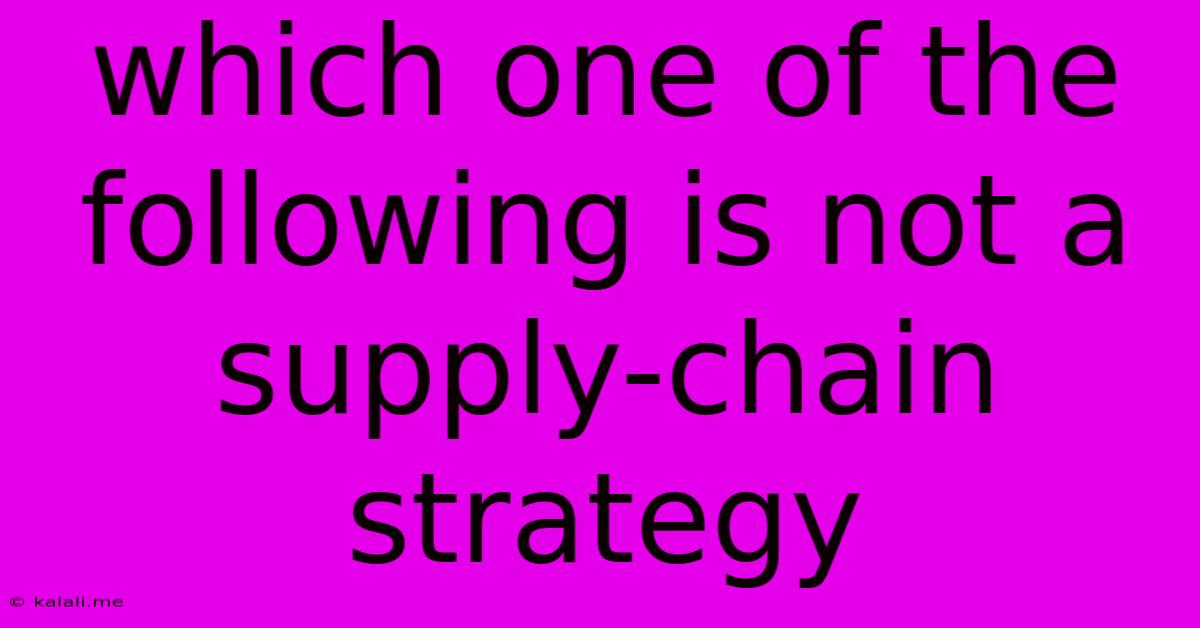Which One Of The Following Is Not A Supply-chain Strategy
Kalali
Jun 14, 2025 · 3 min read

Table of Contents
Which One of the Following is Not a Supply-Chain Strategy? Deciphering the Options
Supply chain management is a complex field, encompassing everything from sourcing raw materials to delivering finished goods to the end customer. Understanding the core strategies involved is crucial for any business aiming for efficiency and competitive advantage. This article explores common supply chain strategies and identifies which of a hypothetical list isn't one. We'll delve into the intricacies of each option to solidify your understanding. The meta description below helps search engines understand the context of this article.
Meta Description: Learn to differentiate between genuine supply chain strategies and unrelated business practices. This article explains various supply chain approaches and clarifies which option is NOT considered a supply chain strategy.
Let's consider a sample set of options to illustrate the point:
A. Just-in-Time (JIT) Inventory Management: B. Lean Manufacturing: C. Mass Customization: D. Aggressive Marketing Campaigns: E. Outsourcing: F. Vertical Integration:
The answer, unequivocally, is D. Aggressive Marketing Campaigns.
While marketing is undeniably important for business success, it's fundamentally separate from supply chain strategy. Let's examine why the other options are indeed supply chain strategies:
Understanding the Core Supply Chain Strategies
-
A. Just-in-Time (JIT) Inventory Management: This strategy minimizes inventory holding costs by receiving materials only when needed for production. It streamlines processes, reduces waste, and enhances efficiency. JIT is a core element of lean manufacturing.
-
B. Lean Manufacturing: A broader philosophy than JIT, lean manufacturing focuses on eliminating waste throughout the entire production process. This includes waste in materials, time, effort, and resources. It's about optimizing efficiency and value.
-
C. Mass Customization: This strategy combines the efficiency of mass production with the personalization of custom-made products. It's a challenge to the supply chain, requiring flexible and responsive processes.
-
E. Outsourcing: This involves contracting a third-party provider to handle specific aspects of the supply chain, like manufacturing or logistics. It's a key decision in supply chain design.
-
F. Vertical Integration: This strategy involves taking control of multiple stages of the supply chain, often by owning or merging with companies involved in different parts of the process. It increases control but also complexity.
Why Marketing Isn't a Supply Chain Strategy
Marketing, although crucial for sales, focuses on promoting and selling products. It's a distinct business function that operates after the product is developed and available through the supply chain. While successful marketing can increase demand, placing pressure on the supply chain to meet this demand, it's not a strategy employed within the supply chain itself.
The Importance of Distinguishing Supply Chain Strategies
Understanding the difference is critical for businesses. Confusing marketing with supply chain strategies can lead to misallocation of resources and inefficient planning. A robust supply chain strategy integrates seamlessly with other business functions, but remains operationally separate. Effective supply chain management requires meticulous attention to detail, from procurement to delivery, ensuring optimal performance across the entire process. Focusing on the correct strategies within the supply chain ensures a strong foundation for business growth.
Latest Posts
Latest Posts
-
What Is The Difference Between Observations And Inferences
Jun 15, 2025
-
Which Digestive Enzyme Hydrolyzes Protein In The Stomach
Jun 15, 2025
-
Which Of The Following Statements Best Describes Scientific Research
Jun 15, 2025
-
Applications Of Series And Parallel Circuits
Jun 15, 2025
-
35 Is What Percent Of 105
Jun 15, 2025
Related Post
Thank you for visiting our website which covers about Which One Of The Following Is Not A Supply-chain Strategy . We hope the information provided has been useful to you. Feel free to contact us if you have any questions or need further assistance. See you next time and don't miss to bookmark.